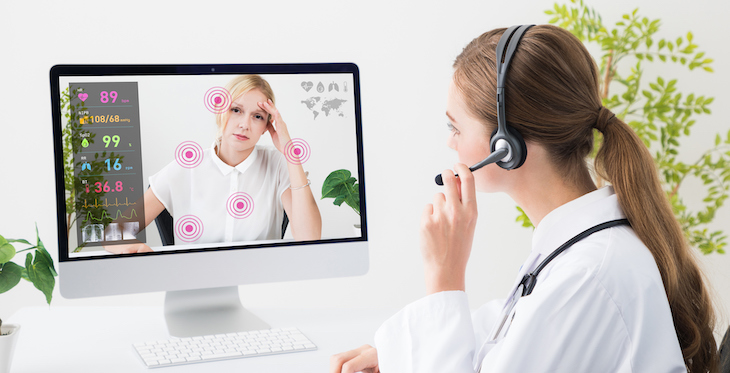Telemedicine - otherwise known as virtual health - refers to the one-on-one consultations between patients and health professionals via video chat, phone call, or text message.
It’s the process of doctors treating patients remotely instead of face to face, using some sort of digital connection for the patient and doctor to connect for a health assessment or mental assessment in real-time. In other words, telemedicine is the answer to healthcare problems for people who work full-time, have young children, have no health insurance, or are otherwise unable to physically go and see a physician because of logistical challenges.
Having the option of simply dialling into a digital appointment with a physician is a gamechanger for any of these people, or for someone is too sick or otherwise unable to do so in person. Additionally, for those without health insurance seeing a physician via a tele-provider is a cheaper out-of-pocket expense than seeing a physician in-person because of the lower overheads, and, considering an estimated 27.5 million Americans don't have health insurance, this could be the solution to some of the country’s most pressing social problems.
Telemedicine describes an industry which has grown exponentially in recent years, as the regulatory barriers which have until now curbed the industry’s growth crumble, enabling an entire industry of digital healthcare providers to provide more efficient and more affordable healthcare to patients. From teleconsultation to telediagnosis, telepharmacy, teleneuropsycology, telerehabilitation and telemental health, the industry is incredibly diverse, offering endless opportunities for physicians, healthcare providers, tech startups and investors seeking to channel their money into “the next big thing”.
So instead of focusing on the grid system or looking into how AI can be used to profit from investments, perhaps investors would be better off looking at the facts - which all indicate 2020 is the year to invest in telemedicine - and investing accordingly.
In 2018, 76 percent of Americans said they prioritise having access to health care over the need for human interactions with care providers, and 30 percent of patients already use smartphones and computers to check for diagnostic information.
Between 2005 and 2017, the number of telemental health consultations conducted in the US grew 56% annually, according to Business Insider Intelligence.
Of telehealth patients receiving services via a mobile app, 80 percent prefer telehealth compared to a traditional in-office visit.
At the same time, 70 to 80 percent of conditions that people seek treatment for can be administered remotely through an online appointment.
Globally, the telehealth sector is predicted to grow into a staggering US$266.8 billion by 2026 with a CAGR of 23.4 percent.
In 2018, there were already an estimated seven million telehealth users worldwide (up from an estimated 350,000 in 2013), and according to Business Insider Intelligence, nearly three-quarters of large US employers offered telemedicine in their health plan in 2018.
Even more tellingly, over 75 percent of Americans say they’re willing to attend a doctor’s appointment remotely.
The stats are telling. There is no doubt whatsoever that telehealth and telemedicine is set to revolutionise healthcare, and as a result, the entire sector is currently ripe for investment. A staggering sum of money has to date already been invested in telemedicine, but this has been mostly limited to organisations investing in personalised telehealth services, and companies investing in new apps.
Given that telehealth relies on the use of technology, more specifically ICTs, to connect patients and health providers, the opportunities in investing in the underlying digital infrastructure required for telemedicine and telehealth to thrive are endless. But investors are warned not to leap too quickly into throwing money behind an app or device without properly understanding the revenue possibilities.
M.D. CEO of WorldClinic, Daniel Carlin has seen firsthand the mistakes made by investors keen to benefit from the industry’s strong growth trajectory. They fail to ascertain how a device or app will actually make money before investing, and assume any investment geared toward telemedicine will do well. Despite their good intentions, nearly 43% of new software-based telemedicine startups fail in their first year.
“Probably the biggest mistake I see on the part of investors is putting money into a promising device or technology without a clear revenue model,” he said. “Most of these young companies will make assumptions based on the overall healthcare market size and anticipated demographic demand, but few can actually show any form of credible early path to revenue or market adoption.”
Already, large telemedicine providers are collaborating with international medical institutions to broaden the telemedicine market on a global scale and generate more revenue, which could mean big possibilities for those who see the industry’s full potential. As parts of Southeast Asia, such as India and China, open their doors to telemedicine the possibilities become truly enormous.
In developed countries such as Australia, the United Kingdom and America, challenges faced by telemedicine startups are all mostly the same: regulatory barriers, adaption to right product-market fit and access to affordable infrastructure. But for those who can overcome these initial barriers, the future of telemedicine is an exciting one, and 2020 is the time to invest.

